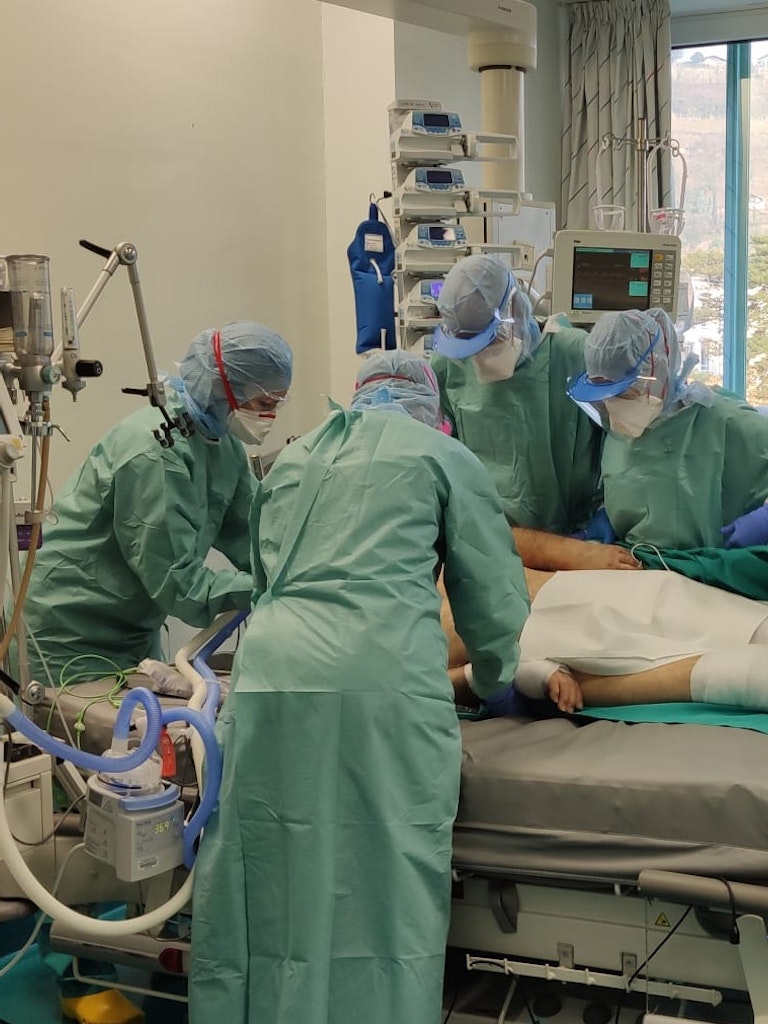magazine_ Article
There is no link between Covid-19 and high-altitude pulmonary oedema
Research team publishes official statement
The hypothesis was put forward by US doctors when the Corona pandemic hit the States. The theory suggested Covid-19 patients strongly resembled cases of altitude sickness induced pulmonary oedema and could therefore, be treated in the same way. Together with colleagues a research team around Hermann Brugger and his institute co-director Giacomo Strapazzon has published an official statement on the differences between the two diseases and why they should not be treated equally.
The hypothesis was put forward by US doctors when the Corona pandemic hit the States - first in a scientific article and then in a Facebook video of a young doctor, operating in New York, which soon became viral. The theory suggested Covid-19 patients strongly resembled cases of altitude sickness induced pulmonary oedema and could therefore, be treated in the same way. "It is incomprehensible to me that it was possible to publish such a notion, and that the reviewers, i.e. the scientifically responsible experts, had no objection to it", marvels Hermann Brugger, head of the Institute for Alpine Emergency Medicine at Eurac Research - research specialists in the field of high-altitude medicine. "Furthermore, it is downright harmful, if not fatal, to use the drugs and therapies effective for high-altitude pulmonary oedema in Covid patients", emphasises Brugger, who hopes that his appeal will be heard in good time. "At present, pre-prints - professional articles that have not been reviewed - are circulating on the Internet. At present it is these articles which are being published in scientifically renowned journals. Such practice has never before been seen on a such a scale," Brugger points out. It is therefore particularly important to read non-reviewed articles with caution. Many proposed therapies have not yet been validated. "We are in a huge worldwide experiment. In good faith, therapies are used that have not undergone the normal approval processes. At best, this can be to the benefit of the patient, but it is also associated with increased risk," warns the physician.
Together with colleagues from the ISMM (International Society of Mountain and Expedition Medicine), UIAA Medcom (Medical Commission of the International Organization of Alpine Associations) and ICAR Medcom (International Commission for Alpine Emergency Medicine), the research team around Brugger and his institute co-director Giacomo Strapazzon have published an official statement on the differences between the two diseases and why they should not be treated equally. This is followed by a summary excerpt, published in the renowned BMJ (British medical Journal), in High Altitude Medicine & Biology and in the European Respiratory Journal.
The main differences between Covid-19 and high-altitude pulmonary oedema
- High-altitude pulmonary oedema is an accumulation of fluid in the lungs that occurs during mountaineering at altitudes above 3,000 metres and can severely impede breathing.
- Even though, both in Covid-19 and high-altitude pulmonary oedema, patients suffer from severe oxygen deficiency (hypoxia), the causality is completely different: in high-altitude pulmonary oedema, hypoxia is the cause of the symptoms, whereas in Covid-19, hypoxia is the consequence of lung damage.
- In high-altitude pulmonary oedema, hypoxia leads to a rapid and sharp increase in blood pressure in pulmonary circulation. Covid-19 also causes elevated blood pressure in pulmonary circulation, but this is not as pronounced and only occurs during the course of the disease.
- Covid-19 is a highly contagious viral disease – high-altitude pulmonary oedema is not an infectious or viral disease.
- As far as signs of inflammation in the lungs are concerned, these can occur (to a lesser extent) in patients with high-altitude lung oedema at a later stage. In Covid-19, the virus destroys the lung cells and leads to a severe inflammatory process.
- High-altitude pulmonary oedema only affects the lungs, while Covid-19 can affect the lungs, kidneys, heart, the nervous and vascular system. As such, patients with high-altitude pulmonary oedema never die from multi-organ failure, whereas Covid-19 patients may.
- The course of high-altitude pulmonary oedema does not depend on the presence of pre-existing diseases. However, in Covid patients, cardiovascular disease or diabetes can significantly worsen the course of the disease.
- The course of high-altitude pulmonary oedema is not affected by age, whereas in Covid-19, age can influence the course of the disease.
Why Covid-19 and high-altitude pulmonary edema should not be treated equally
When oxygen is administered to patients with high-altitude pulmonary oedema, the symptoms disappear within a few days. If it is not possible to evacuate the patient directly from the altitude to lower altitudes, drugs that dilate the pulmonary vessels (calcium antagonists and phosphodiesterase inhibitors) can be effective.
However, these treatments would be harmful for Covid patients: they worsen the ventilation-perfusion ratio and thus promote the acute lung failure that characterises the second phase of pneumonia in Covid-19.
For the outlined reasons, the researchers emphasise that Covid-19 patients should by no means be treated in the same way as patients with high-altitude pulmonary oedema.

